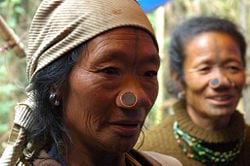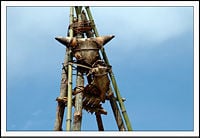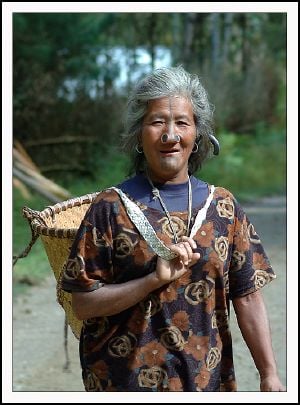Apatani
| Apatani |
|---|

Alternative names: |
| Total population |
| 60,000 |
| Regions with significant populations |
| Arunachal Pradesh, India: 60,000 |
| Languages |
| Indigenious languages, English, Hindi |
| Religions |
| Donyi-Polo, Hinduism, Christianity (Baptist, other) |
| Related ethnic groups |
| Nishi, Adi |
The Apatani or simply Tanii, is a tribal group of about 60,000 (approximately) in Ziro in the Apatani plateau in the Lower Subansiri district of Arunachal Pradesh, India. Their language belongs to the Sino-Tibetian family (see Tani languages).
History
There are currently no known written records of the history of the Apatani tribe, although, throughout their history, the Apatani had a democratic system of running the society. The village council is known as the Bulyang.
One of their oral accounts speak of their migration from the extreme north of Subansiri and Siang areas following the rivers of Kurung and Kiimey. These oral accounts are usually presented in the form of folk tales such as the miji and migung. These accounts, on many occasions are supported by landmarks which still exist on the migratory paths of the Apatanis. At a small village of Yangte in Kurung Kumey district, for example, is a stone beside which the Apatanis held high jump competition on their way to the present habitat. Therefore, these oral accounts have substance but need corroboration with anthropological and scientific evidences. There are reports of such an attempt as the tribes of Arunachal Pradesh are likely to participate in The Genographic Project of the National Geographic.
The miji is a collection of religious chants performed by priests who preside over the sacrifices of mithuns, cows, chickens and pigs during various rituals. A religious song, which may be sung from ten minutes to twelve hours, accompanies all these ritual performances which describes the previous interactions with the spirits or gods, locally known as wui, the content of which explains the origin of the myths among others. On the other hand, the migung is more realistic, since it is narrated in prose, and that the stories within it explain the origins of the Apatani people.
These folk tales include legendary places, and also recent events, such as the downfall of a 19th-century never-do-well. In these two folk tales, both the ritual chants and the prose narrations speak of Abotani, who is reputed to be the original ancestor of the Apatani and the other tribes in central Arunachal Pradesh. These tribes encompass the Tani group, comprising of the Apatanis, Nyishis, Sulungs or Puroiks, Hill Miris, Tagins, Adis and Mishmis.
The first contact with the Europeans occurred in 1897, when British officials came to stay in the valley for two days; six similar brief visits were later held between the 1920s and 1930s. In 1944, after a temporary government outpost was set up by an anthropologist-administrator, the Apatani came in contact with minimal government presence for the first time. When a second but permanent outpost was constructed by the Assam Rifles in 1948, stationed there to protect the land, the Apatanis attacked. The officer in charge retaliated by burning two of their villages.
Religion
Most Apatanis are loyal followers of the Danyi-Piilo faith, who pray to the Sun ( Ayo Danyii) and the Moon (Atoh Piilo). Abotani is revered as the sole ancestor of all Apatani and other tribes in the surrounding regions. When a misfortune occurs, they believe that it is caused by certain spirits, and thus they make appeasement sacrifices of chickens, cows and other domestic animals. Myoko, the festival of friendship and prosperity, is celebrated in a grand manner lasting an entire month in March each year. Dree, celebrated in July is the main agricultural festival of the Apatanis.
There are currently about 1,000 Apatanis who have converted to Christianity, following missionary work done by Mizos in recent years. They are sometimes considered socially inferior by the more orthodox Apatanis.
The ongoing conversion in Ziro has led to the formation of a self-preservation organization among the older generation Apatanis, known as Danyii Piillo Meder Nello. This organization, located at Hari Lemba, Ziro, stands to give a properly organized form to the traditional beliefs and values, and to protect the locals against unquestioned and thoughtless conversion to foreign religions.
Some criticize the organization's use of symbolic representation of Danyi and Piilo as a form of idolatry[citation needed]. They claim the organization is being backed by Hindu organizations and is taking the form of a Hindu sub-religion[citation needed]. Their argument is that the Apatanis have never worshipped idols. This criticism comes predominantly from the Christians. It is important to note that the traditional Apatanis are not Christians and therefore idolatry means nothing to them.
Dress
The dress of the Apatanis is elaborate and colorful, yet simple in style. Tattooing and the stuffing of large nose plugs(Yaping hullo) were once popular among the women, although this practice has gradually fallen into decline in recent years. This practice is believed to have started because the women wanted to look unattractive to males from neighboring tribes. Apatani women were considered to be the most beautiful ones among all the Arunachal tribes.Younger members of this community have stopped this traditional practice.
Traditionally, the men tie their hair in a knot just above the forehead (locally called as piiding) using a brass rod(Piiding Khotu) measuring 12 inches, placed horizontally. Strips of fine cane belt painted in red(Yari), and bent into the shape of a horse-collar with an elongated end, were also worn. These strips of cane are loosely fastened together, with the loop of the horse-collar being tied round the waist. The men also tattoo (Tiippe) their chin, in the shape of a 'T' under the lower lip. The women tattoo themselves with broad blue lines from the forehead to the tip of the nose, and five vertical stripes under the lower lip in the chin. The women bundle up their tresses, which are rolled into a ball(Dilling) on the top of the head. A brass skewer(Ading Akh) may then be inserted horizontally.
Customs and lifestyle
Apatanis trace their descent patrilineally. While the status of men was considered higher than that of women, the sexes share responsibilities in the house and the family.
Apatani women carry out the household chores of gathering both wild and kitchen garden vegetables, cooking, fetching of water, pounding of rice, cleaning of houses, washing of clothes and utensils, nursing, looking after infants and children, preparation of the tsampa, ginning and spinning of cotton and other jobs associated with the household. In the field, the Apatani woman carries out the tasks that include gardening, seeding, transplanting of paddy and millet, padding, weeding of fields and other activities. At home, the internal family income is controlled by a woman. But, the man also has his part of duty in looking after cultivation activities, he acts as the head of family in the society.
Their wet rice cultivation system and their agriculture system are extensive even without the use of any farm animals or machines.So is their sustainable social forestry system. UNESCO is considering the Apatani valley to be declared a World Heritage Site for its "extremely high productivity" and "unique" way of preserving the ecology.[1] In July, the harvest festival of Dree is celebrated with the harvest dance Pakhu-Itu.[2]
The Apatani today
A lot of the information regarding the Apatani tribe currently available in books or on the Internet is known to be fairly outdated. They are generally based on observations made by Professor Christopher von Furer-Haimendorf in the 1940s.
The Apatani have incorporated many ways of the modern world, but the traditional culture and customs still retain their significance. Many of them are high-level Government employees, doctors and engineers and are working far away from their native villages around Ziro. Even so, they make it a point to return to their villages during important festivals, notable among which are Myoko in March and Murung in January every year. Dree, another important festival of the Apatanis are celebrated in all the major towns in Arunachal Pradesh and in some cities outside the state. As in any other developing countries, several teenagers have been influenced by Western culture, but the traditional lifestyles are still maintained.
ReferencesISBN links support NWE through referral fees
- ↑ "Unique Apatani impresses Unesco", Rajeev Bhattacharyya, The Telegraph, 17 June 2005. URL last accessed 21 October 2006.
- ↑ http://www.nezccindia.org/arunachalpradesh/StateFestival.asp?State=Arunachal
External links
- Colonia contact in the "hidden land"
- http://www.pcedindia.com/peoplescomm/tribes_10b.htm
- Fürer-Haimendorf's Apa Tani films
- Anthropological articles of the Apa Tani
- Ethnologue profile
- "Illicit Staple"
| |||||
Credits
New World Encyclopedia writers and editors rewrote and completed the Wikipedia article in accordance with New World Encyclopedia standards. This article abides by terms of the Creative Commons CC-by-sa 3.0 License (CC-by-sa), which may be used and disseminated with proper attribution. Credit is due under the terms of this license that can reference both the New World Encyclopedia contributors and the selfless volunteer contributors of the Wikimedia Foundation. To cite this article click here for a list of acceptable citing formats.The history of earlier contributions by wikipedians is accessible to researchers here:
The history of this article since it was imported to New World Encyclopedia:
Note: Some restrictions may apply to use of individual images which are separately licensed.

